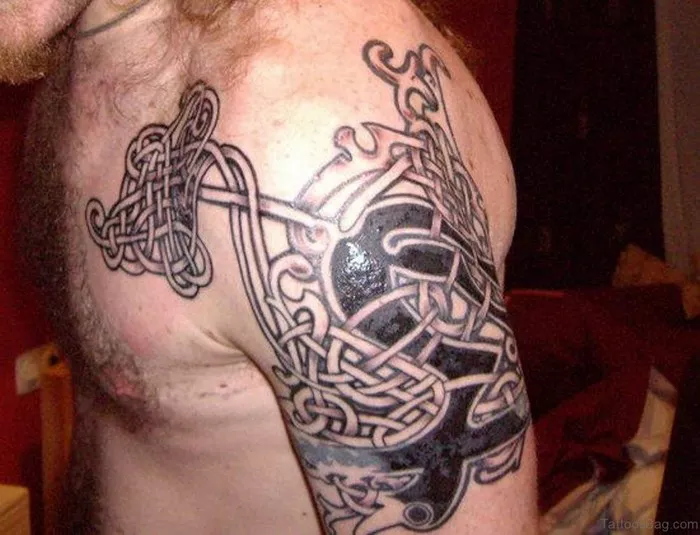Celtic tattoos, with their intricate knotwork, interlacing patterns, and rich symbolism, have captivated tattoo enthusiasts for decades. Rooted in ancient Celtic art and culture, these designs offer a timeless aesthetic appeal and hold profound personal significance for many. However, as with any form of body art, the question of how well Celtic tattoos age is a pertinent one. In this comprehensive exploration, we delve into the various factors that influence the longevity of Celtic tattoos and offer insights into preserving their beauty for years to come.
Understanding Celtic Tattoo Design
Before assessing the aging process of Celtic tattoos, it’s essential to grasp the fundamental characteristics of Celtic art. Celtic design is characterized by its intricate patterns, geometric shapes, and stylized representations of animals, nature, and mythical beings. Knotwork, in particular, is a hallmark of Celtic artistry, symbolizing eternity, continuity, and interconnectedness.
When translated into tattoos, these intricate designs often adorn the skin with striking visual appeal, reflecting the wearer’s connection to Celtic heritage, spirituality, or personal symbolism. However, the complexity of Celtic patterns also poses challenges in terms of tattoo longevity, as fine details and intricate lines are susceptible to distortion and fading over time.
Factors Influencing Tattoo Aging
Several factors influence how well a Celtic tattoo ages, including:
1. Quality of Ink and Tattooing Technique: The type and quality of ink used, as well as the skill of the tattoo artist, play a crucial role in determining the longevity of a tattoo. High-quality ink formulated specifically for tattooing is less likely to fade or blur over time, while skilled tattoo artists can ensure clean lines and precise details that withstand the test of time.
2. Placement on the Body: The location of the tattoo on the body significantly impacts its longevity. Areas subject to frequent friction, such as the hands or feet, are more prone to fading and distortion. Similarly, tattoos exposed to prolonged sunlight may experience accelerated fading and loss of clarity.
3. Skin Type and Lifestyle Habits: Individual differences in skin type, such as elasticity, hydration levels, and sun sensitivity, can affect tattoo aging. Lifestyle habits, including smoking, excessive sun exposure, and poor skincare, can also accelerate the deterioration of tattoos over time.
4. Aftercare and Maintenance: Proper aftercare is essential for preserving the vibrancy and integrity of a Celtic tattoo. Following the tattoo artist’s instructions for cleaning, moisturizing, and protecting the tattooed area from sunlight can help maintain its appearance over time. Additionally, periodic touch-ups may be necessary to refresh colors and sharpen lines as the tattoo ages.
Preserving the Beauty of Celtic Tattoos
While Celtic tattoos have the potential to age gracefully when executed with care and attention to detail, preserving their beauty requires ongoing maintenance and consideration. Here are some tips for ensuring the longevity of your Celtic tattoo:
1. Choose a Reputable Tattoo Artist: Selecting a skilled tattoo artist with experience in Celtic designs is crucial for achieving a high-quality tattoo that ages well. Research artists carefully, view their portfolio, and ensure they use quality ink and adhere to strict hygiene practices.
2. Select an Ideal Placement: Consider the placement of your Celtic tattoo carefully, opting for areas of the body that experience minimal friction and sun exposure. Areas such as the upper back, chest, or thighs are less prone to distortion and fading over time.
3. Practice Proper Aftercare: Follow your tattoo artist’s aftercare instructions diligently, including cleaning the tattooed area gently, applying recommended ointments or moisturizers, and avoiding exposure to sunlight and harsh chemicals.
4. Protect Your Tattoo: Shield your Celtic tattoo from direct sunlight by wearing protective clothing or applying a broad-spectrum sunscreen with a high SPF. Avoid activities that may subject the tattoo to excessive friction or trauma, such as vigorous scrubbing or abrasive clothing.
5. Schedule Regular Touch-Ups: As your Celtic tattoo ages, consider scheduling periodic touch-up sessions with your tattoo artist to refresh colors, sharpen lines, and maintain its overall appearance. Touch-ups can help extend the lifespan of your tattoo and ensure its continued beauty for years to come.
Conclusion
In conclusion, the question of whether Celtic tattoos age well is multifaceted, with various factors influencing the longevity and preservation of these intricate designs. While Celtic tattoos have the potential to age gracefully when executed with skill and care, proper aftercare, maintenance, and consideration of individual factors are essential for ensuring their lasting beauty. By selecting a reputable tattoo artist, choosing an ideal placement, practicing proper aftercare, protecting your tattoo from environmental factors, and scheduling regular touch-ups, you can preserve the vibrancy and significance of your Celtic tattoo for years to come. Ultimately, the decision to get a Celtic tattoo should be made thoughtfully, with a commitment to caring for and honoring the artistry of this timeless form of body adornment.

